Page 1 |
Page 2
Pulp Fiction. It's not just the name of a Tarantino flick. Back in the days of bread lines and hobo jungles, millions of readers found escapist thrills in the pages of cheaply produced magazines printed on rough pulpwood paper. Known as "the pulps", these all-fiction titles catered to every imaginable reading taste from detective yarns to pirate stories, from jungle adventures to science fiction and even romance. But the wildest of them all were the notorious horror tomes known collectively as the shudder pulps.
The so-called "shudder" or "weird menace" titles were a blood-red splash of colour in the grey days of the Great Depression. They announced their monthly wares with circus-poster-style covers featuring voluptuous underdressed beauties being pursued by hordes of leering lunatics as bent as boomerangs. Their promise: cheap thrills, and plenty of them.
In their nightmare universe it was always a dark and stormy night. Tethered damsels suffered in the clutches of fiends from hell—mad surgeons, warped scientists, and masked and cowled cultists, eagerly abetted by legions of demented dwarfs and horny hunchbacks. They stripped, whipped, and boiled their curvaceous victims with the enthusiasm of medieval inquisitors. Even the requisite rock-jawed heroes of these stories suffered a purgatory of horrors in order to rescue their brutally treated fair maidens:
I staggered and went down as some crawling thing flopped against my legs. A swarm of others piled on to me, but finally I was up again, struggling on through that sea of mindless flesh . . . But before my hands reached the thing, it whirled and a bestial snarl writhed from dripping lips.
The weird menace magazines lasted for but a few brief years, roughly from 1933 to 1941, when the actions of blue-nosed watchdogs helped propel them from the market. They remain today as highly prized (and highly priced) examples of a curious phenomenon in the history of popular fiction. Their name was first coined in an attack on them by author Bruce Henry in the AMERICAN MERCURY magazine of April, 1938. He wrote: "This month, as every month, 1,500,000 copies of terror magazines known to the trade as the shudder group, will be sold throughout the nation. They contain enough illustrated sex perversion to give Krafft-Ebbing the unholy jitters."
In contrast to previous horror magazines with their literate but fusty eldritch mysteries, the new breed of terror pulps dared go where no newsstand magazines had gone before. These few magazines were largely responsible for the low opinion people held (and still hold) of the entire pulp fiction field. Many dealers sold them under the counter, and New York's mayor Fiorello La Guardia singled them out when he warned the pulp publishers to clean up their act—or get out of town.
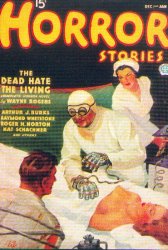
HORROR STORIES (January 1936)
|
With stories written to a strict formula by seasoned pros, shudder pulps featured some of the most unashamedly
lurid fiction and art ever produced for the newsstands of middle America. Each month they announced their presence
with covers illustrating in chromatic detail the titillating promise of stories like:
"Flesh for the Goat Man," "The Corpse Wants Your Widow," "Food for the Fungus Lady" (HORROR STORIES December 1939/January 1940),
"Mate for the Thing in the Box" (DIME MYSTERY MAGAZINE May 1937), and "Summer Camp for Corpses."
Magazine cover art was designed to attract your attention and story titles were meant to sucker you in. If the
author's title wasn't good enough, the editors helped them out, incorporating key words like DARK, PAIN, TERROR,
UNHOLY, DEATH, DEVILS, CORPSE and CORPSES—although few could top Frederick C. Davis' inspired "The Mole Men
Want Your Eyes". And if you think the folks at Full Moon were originators of their title THE DEAD HATE THE LIVING,
think again. A writer named Wayne Rogers dreamed that one up nearly seventy years ago for his yarn in the January 1936 HORROR STORIES.
While shudder pulp fiction did not always hit the salacious peaks (or lows) that covers and story titles indicated, authors did work up a head of adjectival steam mining the weird menace formula. Science fiction great Jack Williamson attempted to explain the requirements to fellow scribes in his August 1937 article in AUTHOR & JOURNALIST:
"The hero must be placed in a situation rousing the greatest possible extremes of fear. This means that he and other sympathetic characters should be menaced by some overwhelming peril against which ordinary measures of defence are useless—they face the unknown, something weirdly astounding, apparently supernatural. There is an editorial requirement, however, that everything has a natural, logical explanation at the end.
"The hero, furthermore, must be himself actually terrified. He mustn't be allowed to doubt the mind-crushing reality of the supernatural menace—not until the last few pages. Despite his fears, however, he must be engaged in constant, vigorous action, to protect and rescue others from the overwhelming forces of horror.
"Every item of setting, characterisation, and incident, should be chosen to stimulate the hero—and with him, the reader—to fear, dread, and horror. And remember that these emotions are strongest and purest when felt for a helpless loved one."
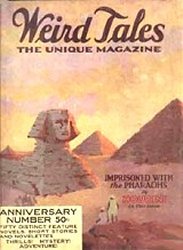
WEIRD TALES (May/June/July 1924)
|
Whether or not the shudder pulps revelled in perverse sex or merely suggested it with leering innuendos and
lurid illustrations is open to debate. In the decade before their introduction the venerable WEIRD TALES magazine had published
a story titled "The Loved Dead", written by C.M. Eddy, Jr. (with a little help from his ghost-writer pal H.P. Lovecraft) which
contained at least one direct reference to the necrophile activities suggested by its title. Eddy claimed later that
citizen's groups in several communities had that issue (May/June/July, 1924) banned from the newsstands. While his claim is doubtful, "The Loved Dead" was not the kind of story that the pulps, much less WEIRD TALES, actively encouraged. Cannibalism was okay, sex was not.
The truth is that for all their sex-and-sadism notoriety, the shudder pulps paid homage to a single basic requirement—the reader must be entertained at all costs. It was a time when working class people sought relief from personal woes through the medium of escapist fantasies. As a rule, the more preposterous the fantasy world created, the easier it was to forget one's own problems. Okay, so it wasn't Shakespeare. It wasn't even good writing. But it was great storytelling. Pulp authors wrote the book on how to tell a story well and they had the good sense not to burden their tales with self-indulgent sermonising. Certainly when it came to the new sub-genre known as the shudder pulps, the term "it's so bad it's good" assumed fresh meaning. As the late, great fantasy author Karl Edward Wagner described it: "No pretensions of art—just go for the throat. An old dark house, a mad fiend on the loose, and twisted henchmen on hand, beautiful and barely clad girls being tortured, a two-fisted hero to the rescue, plenty of heaving alabaster bosoms and mangled bodies, mile a minute thrills and pulse-pounding action . . ."
Good dirty fun, but not politically correct.
The first of the new breed of fiction mags, DIME MYSTERY, lurched on to the newsstands in October of 1933. It
was the brainchild of Popular Publications' resourceful young publisher Henry Steeger, a graduate of Princeton University
and the University of Berlin. In late 1929, when Steeger was in his mid-twenties, he borrowed some money from his stepfather
and, with a partner named Harold Goldsmith, started the Popular Publications pulp chain. At first the partners had only four
titles, a Western, two detectives, and an air war, but by the 1940s were running the biggest pulp publishing house in the world.
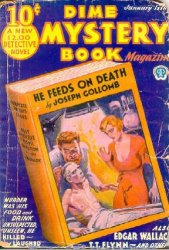
DIME MYSTERY BOOK (January 1933)
|
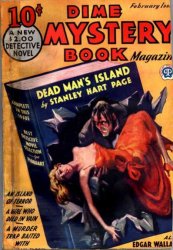
DIME MYSTERY BOOK (February 1933)
|
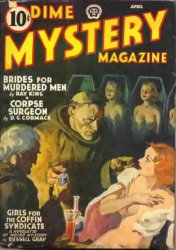
DIME MYSTERY MAGAZINE (April 1940)
|
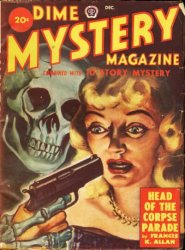
DIME MYSTERY MAGAZINE (December 1949)
|
The youthful partners at the upstart company ran a happy ship, their offices described as a constant madhouse of larks and bantering. Steeger was the company's idea man. He instituted a sassy, extravagant style for their fiction and developed an instinct for cover art that bordered on genius. It must have been fun—even his magazines' story titles mixed sensationalism with dry wit: "You're the Crime in My Coffee," "The Corpse Belongs to Daddy," "This is the Way We Bake Our Dead." A chance remark, a joke, anything would suggest a new title which would be rushed into print.
As new fads replaced old, new magazines sprang up or disappeared like flamboyant weeds. When Steeger's DIME MYSTERY BOOK detective pulp failed to take off after an exploratory dozen issues, he realised that he would have to revamp it totally in order to attract new readers. Inspiration struck him on a trip to Paris when he attended one of the notorious shock plays of Le Theatre du Grand Guignol in Pigalle—a theatrical company which horrified audiences for more than sixty years with live productions featuring graphically explicit scenes of torture, mutilation and bloodshed. Its founder, Oscar Metenier, a playwright of the naturalist movement, pioneered the idea of turning the public's secret fascination with the morbid and bizarre into something of an art form. He was, as cinema's goremeister, Herschell Gordon Lewis, once acknowledged, "a progenitor of all the blood-spilling, eye gouging, limb-hacking, blood-lust boiling just under the surface of apparently civilised human beings . . . a marvellous mirror image of our baser instincts."
While canny publisher Steeger perceived literary possibilities in the transformation of Grand Guignol
gore into pulp, he lightened the brew with the addition of another European influence—that of the Gothic novel. A
phenomenon of the late 18th century, Gothic literature was a movement that focussed on imperilled heroines, demented
villains, death, terror, decay, and a pervasive atmosphere of supernaturalism. Passion overcame reason in these novels,
and such settings as isolated, storm-swept landscapes with crumbling castles and subterranean labyrinths formed their
backgrounds. Steeger reckoned that if he could encourage his stable of authors to combine the visceral appeal of
Le Grand Guignol with the spooky sensibilities of the Goths, he might be able to come up with something new in the world of fiction.
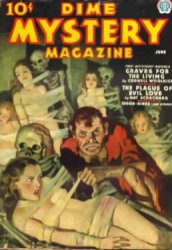
DIME MYSTERY MAGAZINE-Le Grand Guignol
|
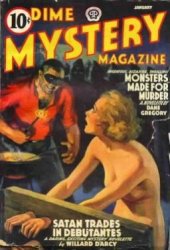
DIME MYSTERY MAGAZINE-Le Grand Guignol
|
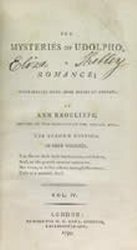
THE MYSTERIES OF UDOLPHO (1794)
|
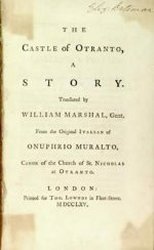
THE CASTLE OF OTRANTO (1764)
|
Horace Walpole's THE CASTLE OF OTRANTO (1764) is generally considered to be the first Gothic novel, but it
was Ann Radcliffe's popular THE MYSTERIES OF UDOLPHO (1794) that was most influential in designing the shudder pulp
formula well over a century later. Mrs. Radcliffe made clear her distinction between the terms "terror" and "horror", saying that terror is induced by anticipation of some fearful happening and that horror is in the culmination of that event. Her chief contribution to the formula, however, was the manner in which she intimated supernatural terrors in her stories, only to explain them away as the handiwork of some calculating human plotter. Dedication to this idea would become the most outrageous aspect of the wildly improbable shudder pulp stories, one guaranteed to test the ingenuity of the most inventive writers.
October of 1933 saw a re-launch of Henry Steeger's ailing DIME MYSTERY BOOK under its abbreviated title, DIME MYSTERY and bearing the subtitle "The Weirdest Stories Ever Told". Gone were the old-fashioned whodunit novels, replaced by rapid-fire examples of the publisher's newly invented shock genre. As the editorial column explained it, "There were good mystery stories and good terror stories appearing in half a hundred different publications long before this magazine ever reached the newsstands . . . but no magazine, to our knowledge, had ever combined these two elements of mystery and terror and devoted its pages exclusively to stories of this one heart-quickening type."
The magazine's lead-off heart quickener went to reliable pulp pro, Norvell Page. His novella "Dance of the Skeletons", asked the breathless question, "Who was the Flesh Destroyer? How could a living man become a meatless nightmare—in two short hours?" The answer involved Manhattan party-goers being stripped of their edible bits by flesh-eating piranha. Page's story was a moderate beginning, but it set the tone and suggested even greater horrors to come.
Infused with new blood (literally), the revamped DIME MYSTERY took off like skyrockets. Encouraged by
success, the magazine's authors began to speed recklessly past the borders of reality in describing the sheer magnitude of
villainous crimes. Many of pulpdom's most prolific tale-spinners, among them the great Hugh B. Cave ("master of the livid phrase"),
Ray Cummings, Arthur Leo Zagat, Paul Ernst, Nat Schachner, Wyatt Blassingame and Arthur J. Burks churned out these tasty titbits
of gruesome gore like strings of Sweeney Todd sausages. Readers must have responded with relish because Popular Publications lost
little time in producing not one, but two companion monthlies, TERROR TALES, followed by HORROR STORIES. Cribbing
a leaf from Mrs. Radcliffe's notebook, editor Rogers Terrill attempted to assist readers (and presumably authors) in differentiating between the titles.
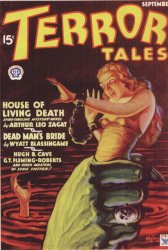
TERROR TALES (September 1934)
|
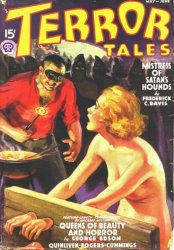
TERROR TALES (May 1938)
|
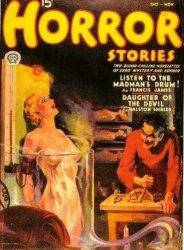
HORROR STORIES (October 1936)
|
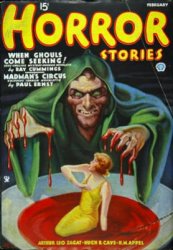
HORROR STORIES (February 1935)
|
"Horror," he admonished, "is what a girl would feel if, from a safe distance, she watched ghouls practice diabolical rites upon a victim. Terror is what the girl would feel if, on a dark night, she heard the step of the ghoul coming toward her and knew she was marked for the next victim."
Truth to tell, there was precious little differences between the titles, despite a hefty fifteen-cent price tag on DIME MYSTERY's two companions. They were, in essence, a single magazine published three times a month, indicating the almost instantaneous popularity of pulp fiction's new fright face.
Under the title "Strong Medicine," the editor's comments in the initial HORROR STORIES concocted a recipe to explain shudder pulp appeal:
With this issue, HORROR STORIES takes its bow—to chill and thrill the thousands who have long asked for and awaited such a magazine. You will find it packed with heart-stopping tales from beginning to end, with gruesome stories that will freeze your blood and leave you rigid in your chair. Squeamish ones will flee from these tales as from the plague. Yet we make no apologies for the contents of this magazine, for we know the need it satisfies.
We know the humdrum life it is given most of us to lead in this modern age, and the many things that it lacks to make us all well-rounded and complete. And the greatest of these is fear and the stimulus it gives.
In other ages man lacked not fear; it was with him always. It prowled the night in a thousand hideous shapes and even stalked the distant places in the light of day. No man knew then, when walking a dark and lonely road at night, what foul Satanic revelry he might stumble upon at the crest of yonder desolate hill. The sword he carried would then avail him little; and even the power of his crucifix might be swept away by the wiles of Beelzebub.
Today we feel but petty fears. They are always with us, distasteful and a hindrance to our happiness. Yet they can be swept away by greater fears, never to return.
This, then, is what we hope to do with HORROR STORIES. It is strong medicine for our ailments, yet strong medicine is what we need. Nor do we plan to weaken the dose in the future. We give you here a handy taste of horror—and if you like it, as we're sure you will, we'll give you more each month!
The idea was that reading HORROR STORIES would make you healthy. Just what the mad doctor ordered.
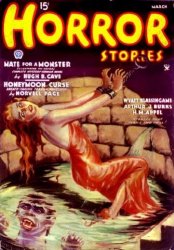
HORROR STORIES (March 1935)
|
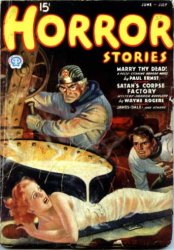
HORROR STORIES (June 1936)
|
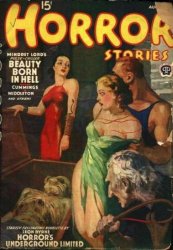
HORROR STORIES (August 1938)
|
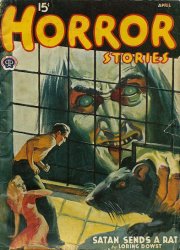
HORROR STORIES (April 1941)
|

